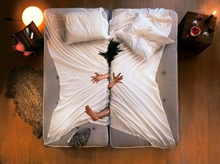Box-spring
A box-spring (or divan in the UK, where they don't use such common vulgarities as box) is a type of bed base. These are generally designed to give the general approximation of comfort while in the store testing the bed, but are designed to cause discomfort from the moment of installation within a home.
The construction of these nominally entitled beds typically consist of a wooden frame, covered in dust mite friendly cloth, and containing what are referred to as bedsprings. These bedsprings are tested against several criterion, known colloquially as the "four c's". These are:
- Clarity
- Carat
- Color (or colour in the UK, where extraneous vowels are the preferred norm).
- Cut
- Certificate
Clarity
Most wire coils contain some inner flaws (or inclusions in the UK), that occur in the manufacturing process. Highly skilled manufacturers work on adding these in an extremely calculated manner. The purpose of these is to allow the bed to have an initial softness or "comfort" factor, but due to these inclusions the springs will quickly weaken, deform, snap, or generally just become completely screwed up. Hairline fractures that occur laterally along the direction of the spring are highly sought (or "saught" in the UK), along with air bubbles in the spring itself.
A well clarificated spring is designed to snap after a period that is equal to the time of warranty for the bed plus one week, and create jagged edges that will lacerate unsuspecting users (or "sleepers" in the UK).
Carat
A carat is a unit of weight by which a spring is measured. There is no definitive reason as to why they are not measured in pounds and ounces (or "kilogrammmes" in the UK). Many spring manufactures, known and springsmiths, will tell you that this is purely as a result of years of tradition, but the more likely reason is that the understanding of bedsprings is designed to be as painful as the springs themselves,
Colo(u)r
Bedsprings are often judged based upon their color, indicating that the majority of springsmiths are in fact closet racists.
Cut
The most important aspect of the five four c's is the cut. This is the measure by which a user will become lacerated by the spring during an average nights sleep. While intuitively this would be believed to be related to the sharpness (or "bladiness" in the UK) of the spring, the amount that a user will turn and toss during the night also has a significant impact. If a user is wakened to the point of getting out of the bed and finding a more comfortable patch of earth on which they can rest their weary bones, this will reduce the overall laceration level experienced.
As such the major art to the springsmiths art is to find the ideal balance between discomfort and comfort, sharpness and dullness, tossiness and untossiness. Highly developed practitioners of this art are referred to among other practitioners as "huge tossers".
Certificate
Due to the sadistic nature of springsmiths, a significant number of them are classed as mentally unstable, and are definitely certifiable. While the ceritifiabilitiness of the springsmith makes no actual difference to the capacity of the bed itself, bedsprings made by completely barking mad springsmiths are a highly sought after commodity.
Alternatives
Beds are more commonly found in United States, Canada, Australia, and in bedrooms.
Alternatively, in Japan, people sleep on futon mattresses placed on the floor. These are so named as due to the low altitude they tend to get walked over, so sleepers often find they will wake up with a foot on their face. In the UK, mattresses are usually placed on a slatted base on the bedframe, because they like to be obtuse and disagree with the rest of the world and the way they do things. In the Middle East there are no beds, so the main alternative is to avoid sleep. This of course tends to make people cranky, and is a significant reason as to why there is war in these areas. Edward de Bono, a renowned lateral thinker, has created plans for sending inner spring mattresses to the Middle East as part of his plan for world peace. [1]
References
| Featured version: 28 August 2015 | |
| This article has been featured on the main page. — You can vote for or nominate your favourite articles at Uncyclopedia:VFH. | |


